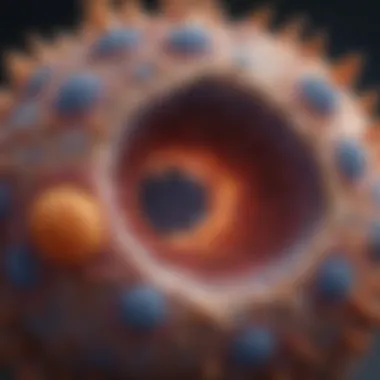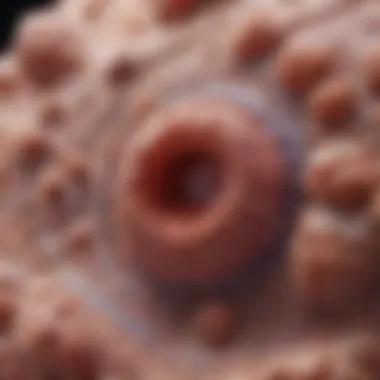Comparative Analysis of Squamous Cell and Basal Cell Carcinoma


Intro
Skin cancer remains a significant health concern worldwide, with various forms impacting millions of individuals. Two primary types are squamous cell carcinoma (SCC) and basal cell carcinoma (BCC). Understanding the differences between these carcinomas is essential for effective prevention, diagnosis, and treatment.
As we delve into squamous cell carcinoma and basal cell carcinoma, this article will present an in-depth analysis. We will explore their unique characteristics, risk factors, treatment strategies, and prognosis differences. By examining these elements, we hope to clarify which type poses greater risks to patient health and to dispel common misconceptions surrounding skin cancers.
Key Concepts
Definition of the Main Idea
Both types of skin cancer arise from the epidermis but differ significantly in their cell origins, behavior, and implications.
- Squamous Cell Carcinoma: This cancer originates from squamous cells, which are flat cells located in the outer layer of the skin. SCC is known for its potential to metastasize, making it more aggressive compared to BCC.
- Basal Cell Carcinoma: This type stems from basal cells, which are found in the lower part of the epidermis. BCC is generally less aggressive and rarely metastasizes, making it typically less life-threatening than SCC.
Overview of Scientific Principles
The biology of both carcinomas involves complex interactions between genetic and environmental factors. It is vital to consider aspects like UV radiation exposure, skin type, and immune system status when evaluating risk.
- Risk Factors: Common risk factors for both SCC and BCC include regular sun exposure, tanning bed use, fair skin, family history of skin cancer, and immunosuppression.
- Prevention: Regular skin checks and proper sun protection strategies are crucial for reducing the likelihood of developing these carcinomas.
Current Research Trends
Recent Studies and Findings
Recent research has focused on improving diagnostic methods and treatment options for skin cancer. Studies have shown promising results in understanding the molecular mechanisms underlying SCC and BCC.
- Innovative imaging technologies are now being utilized to detect early-stage carcinomas. These developments are aimed at enhancing early diagnosis and ultimately improving patient outcomes.
- Research continues to explore the effectiveness of immunotherapy as a treatment option for SCC, showing potential for a more tailored approach to patient care.
Significant Breakthroughs in the Field
The landscape of skin cancer treatment is evolving. Groundbreaking studies have provided insights into the genetic mutations associated with SCC and BCC, leading to new targeted therapies.
"Advancements in genomics are providing hope for more personalized treatment approaches, which could fundamentally change the way we manage skin cancer."
"Advancements in genomics are providing hope for more personalized treatment approaches, which could fundamentally change the way we manage skin cancer."
Understanding Skin Carcinomas
Understanding skin carcinomas is a critical aspect of dermatological health. These are among the most common types of cancer affecting the skin, with implications that extend beyond mere aesthetic concerns. Skin carcinomas, particularly squamous cell carcinoma and basal cell carcinoma, represent significant public health issues. The rising incidence rates convey a pressing need for awareness and education regarding risk factors, clinical presentation, and treatment options.
One of the central reasons for delving into dermatological malignancies is their early detection potential. Early intervention markedly improves outcomes for individuals diagnosed with these skin cancers. Therefore, equipping individuals and professionals with knowledge about the signs and symptoms can save lives. This understanding also helps demystify some misconceptions surrounding skin cancer, fostering more productive discussions about risk factors and preventive measures.
In this article, we will break down the various elements of skin carcinomas. By examining specific definitions, common types, and variations in behavior and severity, we facilitate improved comprehension among a diverse audience, ranging from students to seasoned medical professionals. Ultimately, the information presented here aims to enhance public knowledge and clinical practices relating to skin cancers.
Definition of Carcinoma
A carcinoma is a type of cancer that originates in the epithelial cells, which are the cells that line the surfaces of the body, including skin, glands, and organs. Carcinomas account for a significant proportion of cancer cases, divided primarily into two categories: squamous cell carcinoma and basal cell carcinoma, both of which arise from different types of epithelial cells. Each type exhibits distinct biological behavior, treatment approaches, and prognostic outcomes.
Overview of Skin Cancer Types
Skin cancer broadly comprises three primary types: basal cell carcinoma, squamous cell carcinoma, and melanoma, with the first two being classified as non-melanoma skin cancers.
- Basal Cell Carcinoma: This is the most common skin cancer, often characterized by slow growth and a low chance of metastasis. It typically appears as a pearly bump and often arises from areas exposed to the sun, signifying a strong link to UV radiation exposure.
- Squamous Cell Carcinoma: While also related to sun exposure, this type has a higher potential for metastasis compared to basal cell carcinoma. It may present as a scaly red patch, sore, or wart-like growth. Early detection and treatment are crucial for favorable outcomes.
- Melanoma: This is the most aggressive type of skin cancer but less common than the other two. It arises from melanocytes, leading to significant health risks and requiring more complex treatment strategies.
In summary, understanding these skin cancers is vital for effective management and prevention strategies. The clear distinction between tumor types lays the foundation for further exploration into each type's risk factors, clinical presentation, and treatment modalities.
Squamous Cell Carcinoma


Squamous Cell Carcinoma (SCC) represents a considerable focus in the study of skin cancers due to its distinct characteristics and clinical implications. Understanding the nuances of SCC not only aids in proper diagnosis and treatment but also equips health professionals and patients with knowledge for better health outcomes. Recognizing risk factors specific to SCC can lead to more effective prevention strategies. Furthermore, understanding how SCC behaves compared to other skin cancers is crucial for managing patient care efficiently.
Etiology and Risk Factors
The etiology of Squamous Cell Carcinoma is multifactorial, with ultraviolet (UV) radiation being a significant contributing factor. Chronic exposure to sunlight increases the risk of developing SCC due to DNA damage in skin cells. Other risk factors include:
- Skin type: Fair-skinned individuals are more prone to SCC.
- Previous skin lesions: Individuals with prior actinic keratosis or a history of skin cancer are at higher risk.
- Age: The risk increases with age, particularly in those over 50.
- Immunosuppression: Patients on immunosuppressive therapy, particularly organ transplant patients, face elevated risks.
Understanding these factors helps in recognizing high-risk individuals and allows for preventative actions to be implemented.
Clinical Presentation
SCC often presents clinically in several ways, which can vary depending on its location. Common characteristics include:
- Raised, rough patches of skin: These lesions may be scaly.
- Non-healing sores: Ulcers or sores that do not heal within weeks can signal SCC.
- Wart-like growths: Additional signs may include growths resembling warts.
These clinical manifestations require careful examination, as they can sometimes be mistaken for benign conditions.
Diagnosis and Staging
Diagnosis of SCC typically involves a physical examination followed by a biopsy to confirm malignancy. The staging of SCC is pivotal since it impacts treatment choices and prognosis. Key stages include:
- Stage 0: Carcinoma in situ, limited to the epidermis.
- Stage I: Tumors that are small but invasive.
- Stage II and III: Larger, invasive tumors with potential lymph node involvement.
Proper staging is essential for determining the extent of the disease and appropriate therapeutic approaches.
Treatment Modalities
Treatment options for SCC vary based on the stage and location of cancer. Common modalities include:
- Surgical excision: Removing the tumor along with surrounding healthy tissue.
- Mohs micrographic surgery: A precise surgical technique for higher-risk areas.
- Radiation therapy: Often used for patients unable to undergo surgery.
- Topical chemotherapy: Creams containing chemotherapeutic agents may be suitable for superficial lesions.
Each treatment pathway is chosen based on individual patient factors, emphasizing the need for personalized medical approaches.
Prognosis and Outcomes
The prognosis for Squamous Cell Carcinoma generally depends on various factors such as location, size, and histological subtype. In most cases, when detected early, the survival rate is favorable, often above 90%. However, certain high-risk SCCs can metastasize, leading to more serious outcomes. The overall management strategy aims for not only treating the malignancy but also improving quality of life through regular follow-ups.
Important Note: Early detection is crucial in improving outcomes for patients with SCC. Regular skin checks and awareness of changes in the skin can significantly impact prognosis.
Important Note: Early detection is crucial in improving outcomes for patients with SCC. Regular skin checks and awareness of changes in the skin can significantly impact prognosis.
Basal Cell Carcinoma
Basal cell carcinoma (BCC) holds significance in the field of dermatology as the most commonly diagnosed skin cancer. It arises from the basal cells of the skin, which are located in the lowest layer of the epidermis. Understanding BCC is essential not only for clinical practice but also for public health awareness. The high prevalence underscores the necessity for effective early detection and treatment strategies. Along with its relatively low metastatic potential compared to other skin cancers, such as squamous cell carcinoma (SCC), the details of BCC offer unique insights into skin health management.
Etiology and Risk Factors
The etiology of basal cell carcinoma is primarily linked to ultraviolet (UV) radiation exposure. Individuals with lighter skin types, who may not tan easily, are at a greater risk. Furthermore, a history of sunburn, especially during childhood, significantly increases the likelihood of developing BCC later in life.
Additional risk factors include:
- Age: Most cases are diagnosed in older adults, although recent trends show rising incidence in younger demographics.
- Genetic predisposition: Conditions like Basal Cell Nevus Syndrome heighten susceptibility.
- Environmental influences: Exposure to certain chemicals, such as arsenic or coal tar, may contribute.
- Immune system suppression: Individuals with weakened immune systems are also at a higher risk.
Clinical Presentation
Clinically, basal cell carcinomas present in various forms, which is crucial for accurate diagnosis. Common manifestations include:
- Nodular BCC: Appears as a pearly, raised nodule, often with small blood vessels on its surface.
- Superficial BCC: Presents as a scaly red patch, frequently mistaken for eczema or psoriasis.
- Sclerosing BCC: Can appear as a scar-like lesion, making detection more challenging.


Other variations exist, but early identification is crucial to prevent progression. Patients may notice changes such as growths that bleed or do not heal, which necessitates further evaluation.
Diagnosis and Staging
The diagnosis of basal cell carcinoma typically involves a clinical examination followed by a biopsy. The biopsy provides a definitive diagnosis, allowing dermatopathologists to evaluate the characteristics of the tumor.
Staging is generally not as extensive as with melanoma or SCC, given the low risk of metastasis. However, determining the extent of local invasion can be important in planning treatment. Advanced BCC may be classified through imaging studies to assess local tissue involvement.
Treatment Modalities
Treatment approaches for basal cell carcinoma depend on various factors, including tumor size, location, and patient considerations. Common treatment methods include:
- Surgical excision: Removal of the cancerous tissue along with a margin of healthy skin.
- Mohs micrographic surgery: This technique minimizes the removal of healthy tissue while ensuring complete cancer removal; it is particularly effective for BCC in cosmetically sensitive areas.
- Topical chemotherapy: Creams containing medications such as 5-fluorouracil are used for superficial BCCs.
- Photodynamic therapy: Utilizes light-sensitive medication and a light source to destroy cancer cells.
- Radiation therapy: Sometimes considered for patients who are not surgical candidates.
Prognosis and Outcomes
Prognosis for basal cell carcinoma is generally favorable. The cure rate for BCC is high, especially with early detection and appropriate treatment. Most patients live free of cancer following treatment. However, recurrence can happen, particularly in individuals with a history of skin cancer. Regular follow-ups and skin checks are recommended to monitor for new lesions.
Certain factors may influence outcomes:
- Size and depth of the tumor: Larger or more invasive tumors may have worse outcomes.
- Patient health: Individuals with compromised immune systems may have higher risks of recurrence.
- Tumor location: Cancers on the face or head may be more challenging to treat effectively due to cosmetic concerns.
In summary, understanding basal cell carcinoma provides critical insights into skin cancer management and presents opportunities for preventive strategies in at-risk populations.
In summary, understanding basal cell carcinoma provides critical insights into skin cancer management and presents opportunities for preventive strategies in at-risk populations.
Comparative Severity of Squamous and Basal Cell Carcinoma
Understanding the comparative severity of squamous cell carcinoma (SCC) and basal cell carcinoma (BCC) is crucial for several reasons. Firstly, public awareness of these skin cancers can lead to earlier detection and improved outcomes. Both types, while they generally have a favorable prognosis compared to other cancers, exhibit differences in behavior, treatment, and potential for metastasis. This understanding allows for better guidance on preventive measures and treatment options tailored to individual patient profiles.
Additionally, distinguishing the severity of SCC from BCC aids healthcare professionals in resource allocation and managing patient expectations. As skin cancers become more prevalent globally, distinguishing their characteristics becomes fundamental for optimizing patient care.
Incidence and Prevalence
Incidence refers to the number of new cases diagnosed within a specific time period, while prevalence encompasses the total number of existing cases in a given population. In terms of skin cancers, BCC is the most commonly diagnosed type, with estimates suggesting that it accounts for about 80% of all skin cancer cases. On the other hand, SCC represents about 20% of skin cancers but has been on the rise due to increased sun exposure and tanning bed usage. Factors affecting incidence include age, skin type, and exposure to ultraviolet (UV) radiation.
Skin cancer incidence continues to rise in several countries, highlighting the importance of effective public health strategies.
Skin cancer incidence continues to rise in several countries, highlighting the importance of effective public health strategies.
Metastasis Potential
Metastasis potential is a significant determinant when comparing SCC and BCC. Basal cell carcinoma very rarely metastasizes, making it less life-threatening than SCC. In contrast, squamous cell carcinoma has a higher propensity for spreading to other parts of the body. The likelihood of metastasis increases with factors such as tumor size, location, and depth of invasion. It is essential for healthcare professionals to monitor these variables carefully, especially in patients at higher risk, including those with a history of skin cancer or compromised immune systems.
Recurrence Rates
Recurrence rates can vary greatly between the two types of carcinomas. Basal cell carcinoma, when excised properly, has a low recurrence rate, often around 5-10%. However, those who have had one BCC are at increased risk for developing subsequent basal cell tumors. Conversely, squamous cell carcinoma presents with higher recurrence rates, typically ranging from 10-20%. Several factors influence these rates, including tumor thickness and the effectiveness of initial treatment. Regular follow-ups are critical for early detection of any recurrent cases of SCC.
By understanding these differences, patients and healthcare providers can make informed decisions regarding monitoring and treatment strategies for skin carcinomas.
Common Misconceptions About Skin Carcinomas
Understanding the common misconceptions surrounding skin carcinomas plays a vital role in educating patients and healthcare providers. Many people hold inaccurate beliefs, which can lead to either undue fear or a false sense of security. This article focuses on two primary types: squamous cell carcinoma (SCC) and basal cell carcinoma (BCC). Addressing misconceptions helps to promote a clearer knowledge base about these conditions, allowing for informed decisions regarding surveillance and treatment.
Aggressiveness Assessment
A significant misconception is that all skin carcinomas are equally aggressive. In reality, this is not true. Basal cell carcinoma tends to be the least aggressive among skin cancers and is rarely fatal. It generally grows slowly and does not typically metastasize. In contrast, squamous cell carcinoma may present a greater risk. Though often localized, it has the potential to invade deeper tissues and metastasize, especially if left untreated.
Healthcare professionals need to assess each case individually. Factors such as the tumor size, location, and patient health determine the actual aggressiveness of the carcinoma. It's worth noting that even though BCC is less aggressive, it can still cause significant local damage if ignored.


"Patient education is crucial in altering misconceptions and improving outcomes when it comes to skin carcinomas."
"Patient education is crucial in altering misconceptions and improving outcomes when it comes to skin carcinomas."
Treatment Approaches
The treatment approaches for squamous cell and basal cell carcinoma are another area rife with misunderstandings. Many believe that surgical intervention is always necessary for all types. While surgery is a common method, it's not the only one. Basal cell carcinoma may sometimes be treated with topical agents, especially in superficial forms. Mohs micrographic surgery is often employed for both BCC and SCC to ensure complete removal and to minimize skin loss.
In instances of squamous cell carcinoma, treatment options can include:
- Cryotherapy: Freezing the tumor to remove it.
- Radiation therapy: Used especially when surgery is not feasible.
- Systemic therapy: Medications that target cancer cells may be necessary in advanced cases.
For basal cell carcinoma, the management strategy might include:
- Topical chemotherapy: Suitable for superficial BCC.
- Electrosurgery: Using electrical currents to eliminate growths.
By clarifying these treatment modalities and their indications, individuals can better understand what steps may be appropriate based on their specific diagnoses.
Recommendations for Monitoring and Prevention
In understanding skin cancer such as squamous cell carcinoma and basal cell carcinoma, monitoring and prevention become vital components. Regular assessments aid in early detection, which is crucial for successful outcomes. Patients and healthcare professionals must maintain an awareness of skin changes that may indicate the presence of skin carcinomas. This proactive approach can lead to earlier interventions, which often result in improved prognoses.
The benefits of adopting a routine for skin assessments and preventive measures cannot be overstated. They empower individuals to take charge of their skin health and recognize alarming symptoms, fostering a comprehensive understanding of their unique risk profiles. Both factors significantly enhance the ability to mitigate adverse outcomes associated with carcinomas.
Regular Skin Assessments
Regular skin assessments are essential for identifying any changes that could indicate skin carcinoma. These assessments can take place during a dermatologist visit or can be self-examinations performed at home. Individuals should be aware of the ABCDEs of moles:
- Asymmetry: One half does not match the other.
- Border: Irregular, scalloped, or poorly defined edges.
- Color: Varying shades or colors.
- Diameter: Larger than 6mm.
- Evolving: Changes in size, shape, or color.
Proactive skin monitoring helps in evaluating new growths or changes in existing moles. This process should begin early, especially for at-risk populations, like individuals with fair skin, a history of sunburns, or family history of skin cancer. Regular check-ups facilitate conversations between patients and dermatologists about any concerns, leading to timely biopsies or other diagnostic procedures, if needed.
Sun Protection Strategies
Sun protection strategies are of utmost importance in preventing skin carcinomas. Ultraviolet radiation is a primary risk factor for both squamous cell carcinoma and basal cell carcinoma, making sun safety crucial.
Several effective sun protection measures include:
- Using sunscreen: Select a broad-spectrum sunscreen with an SPF of at least 30. Reapply every two hours when outdoors, or more frequently if swimming or sweating.
- Wearing protective clothing: Fabrics that cover the skin help minimize UV exposure. Consider clothing with built-in UV protection.
- Seeking shade: Especially during peak sun hours, typically between 10 a.m. and 4 p.m.
- Avoiding tanning beds: Tanning beds increase the risk of skin cancer, particularly among young individuals.
By implementing these strategies, individuals can significantly reduce their risk of developing skin cancer. Education on sun safety can enhance community awareness and promote healthier behaviors among populations.
"Prevention is better than cure." By adopting these preventive measures, individuals not only protect themselves from skin carcinomas but also instill a culture of health awareness in their communities, fostering an environment where skin health is prioritized.
"Prevention is better than cure." By adopting these preventive measures, individuals not only protect themselves from skin carcinomas but also instill a culture of health awareness in their communities, fostering an environment where skin health is prioritized.
The End
The exploration of squamous cell carcinoma and basal cell carcinoma is vital in understanding skin cancer and its implications for health. A clear comprehension of the characteristics, behaviors, and treatment options can significantly impact a patient's journey after a diagnosis. This conclusion aims to synthesize the information provided throughout the article, emphasizing the importance of distinguishing between the two types of carcinomas for better management and outcomes.
Summary of Findings
Both squamous cell carcinoma and basal cell carcinoma represent significant health concerns, yet they differ in critical ways.
- Etiology and Risk Factors: Prolonged sun exposure is a notable risk factor for both, yet squamous cell carcinoma also has a stronger association with immunosuppression.
- Clinical Presentation: Squamous cell carcinoma often presents as a firm, red nodule or a flat sore that bleeds. Basal cell carcinoma may appear as a waxy bump or flat, scaly spot.
- Diagnosis and Staging: Both types require distinct approaches for diagnosis and staging, influencing treatment decisions and prognosis.
- Treatment Modalities: Treatment for squamous cell carcinoma may be more aggressive due to its potential for metastasis, while basal cell carcinoma generally has a favorable treatment outcome with a lower risk of Spread.
- Prognosis and Outcomes: While basal cell carcinoma is rarely fatal, squamous cell carcinoma carries a risk of metastasis, making prognostic considerations essential for patient care.
These findings highlight the need for continued education and awareness among both patients and healthcare professionals regarding the differences in presentation, treatment, and outcomes of these carcinomas.
Future Directions in Research
Future research should focus on several key areas to enhance understanding and management of squamous cell and basal cell carcinomas:
- Genetic and Molecular Studies: Investigating the molecular pathways that contribute to the development of each carcinoma can reveal new targets for therapy.
- Immunotherapy: Continued exploration into how the immune system interacts with cancer cells can lead to innovative treatment strategies, particularly for squamous cell carcinoma.
- Prevention Programs: Development of tailored prevention campaigns focusing on at-risk populations could reduce incidence rates.
- Long-term Outcomes Tracking: Systematic tracking of long-term outcomes in patients treated for these carcinomas can inform future clinical practices.
In summation, advancing knowledge in these areas can positively affect patient care, ultimately leading to better management strategies and improved outcomes for individuals facing these forms of skin cancer.







